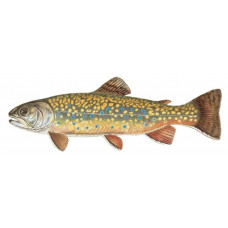Latin name
Salvelinus fontinalus
Other names
No information
Identification
The charr group includes only one species that is actually called 'charr' in English, Salvelinus alpinus, which is also called S. alpinus in some scientific texts. The four cousins of Arctic charr include the two best-known species, S. namaycush and S. fontinalis, as well as two less well-known species, S. malma and S. confluentus. Sharp and other members of the family Salmonidae are primitive fish. Their fossil remains date back more than 100 million years. Evidence suggests that many of the more evolved or specialized families of modern bony fishes have ancestors closely resembling these primitive fishes. The most distinctive primitive feature of the group is the absence of fin spines. Most of the soft rays in the fins are branched. The pelvic fins are located far back on the body - in the "thigh" region, where the amphibian's legs articulate with the body. This position differs from the arrangement of the pelvic fins in many other species, including, for example, largemouth bass, in which the pelvic fins are so far forward that they are almost directly below the pectoral fins. Other signs of the primitive nature of this species are the adipose fin and a coarse type of air bladder. As a group, the Sharks are among the most conspicuous and beautiful freshwater fish. Some of them are particularly colorful, especially during the spawning season. They all have characteristic markings on their bodies, although there are large variations depending on their habitat. For example, a lake trout that lives in the depths of one of the Great Lakes is quite bland compared to a lake trout caught in the more sterile waters of the far north. Some populations of various char species have declined drastically and most are no longer what they were decades ago, both in overall size and in the number of large specimens. In addition, some landlocked forms with limited distribution have become extinct, and in some cases their extinction has been accelerated by stocking with non-native salmonids. The question of the correct spelling of this group, charr or char, has sparked much debate in the scientific community. The original and historical spelling is reported to be Celtic (from Ceará, meaning "blood-red") and in 17th century England it became "charre" and then "charr". The general public, especially the popular media, predominantly use "char" today. Many Canadian ichthyologists, who may have more rights to this group because of the abundance of these species and their study, use "charr".
Distribution
Sharks are endemic to the temperate and cool regions of the Northern Hemisphere, but are widely distributed outside their native range.
Habitat
Most members of the Salmonidae family are in one way or another associated with cold, often swift waters and high oxygen demand. Some of them, including two species of charr, are also linked to the sea, spending part of their lives there. All members of the family spawn in fresh water, and most require cold running water. Some marine species, including at least the arctic charr, are inadvertently or deliberately landlocked, living and successfully breeding exclusively in freshwater, never travelling to saltwater.
Size
No information
Life history and Behavior
No information
Food and feeding habits
No information
Reproduction
The female builds a depression in a spot in the stream bed where groundwater seeps up through the gravel. One or more males approach the female, fertilising the eggs as the female lays them. Most spawning involves peripheral males, which directly affects the number of eggs that survive to maturity. In general, the more peripheral males present, the more likely the eggs will be eaten. The eggs are slightly denser than water. The female then buries the eggs in a small gravel mound. They hatch after 95-100 days.
| Classification | |
| Phylum | Chordata |
| Class | Actinopterygii |
| Squad | Salmoniformes |
| Family | Salmonidae |
| Genus | Salvelinus |
| Species | S. fontinalis |
| Features | |
| Conservation status | Secure |
| Habitat | Pelagic |
| Life span, years | 3 |
| Maximum body weight, kg | 3 |
| Maximum length, cm | 65 |
| Sailing speed, m/s | No information |
| Threat to people | Edible |
| Way of eating | Predator |
Charr: Brook Trout
Tags: Charr: Brook Trout



